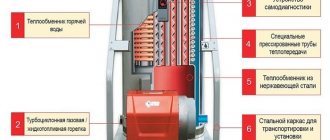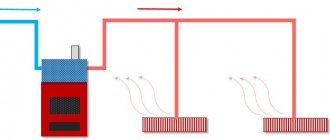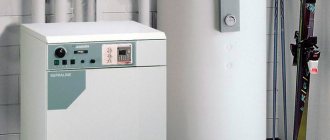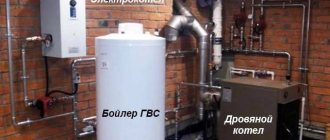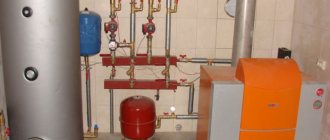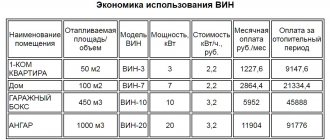Advantages
The advantages of gas boilers for heating for a private home usually include the following characteristics:
- Easy installation and operation. The organization of a gasified heating system involves the use of standard fasteners and connecting elements. They can be easily found in any hardware store, which allows you to install the equipment quickly and without much difficulty.
- Ability to carry out a certain amount of work independently. Such activities include purchase, assembly, selection of a suitable location and installation of the device. As for the startup and commissioning of gas heating boilers for a private home, this is allowed to be done only by specialists with the appropriate qualifications and permission. After commissioning activities, the equipment is sealed.
- High level of efficiency of a private gas boiler house. If you include a circulation pump in the heating system for forced supply of coolant, this will allow you to heat a large area of the house in a short time. This is especially convenient in cases where the building is used irregularly.
- Economic factor. Gas boilers are characterized by a high level of efficiency, since gas in most regions of our country is one of the cheapest types of fuel. To calculate the estimated volumes for heating a house, a special formula is used, where 1 m2 of energy resource consumed is multiplied by the heated area of the building. However, it should be understood that purchasing a gas heating boiler only makes sense if there is a main gas pipeline located nearby.
- Fire safety. If you follow all the rules for operating gas equipment, fires are completely excluded. Thanks to the use of a special scheme for removing products of incomplete combustion during the operation of the boiler, the risk of burning is also reduced to zero.
- Availability of special sensors. This allows you to control the gas supply, burner operating parameters and temperature conditions, which makes the system completely safe, making it possible to leave it unattended for a long time.
- A small percentage of formation of harmful substances as a result of combustion. For this reason, the gas combustion process is considered to be the most environmentally friendly.
- Compact size of a gas boiler with high power. This allows installation of equipment without compromising the integrity of the interior. This is especially true for wall-mounted gas boilers for heating a private home, which have a beautiful design.
- Durability. Gas boilers can operate without problems for up to 20 years. The use of cast iron units increases this figure to 50 years (read: “What are cast iron gas boilers - types, differences, how to choose and install”).
When considering a gas boiler as an option for installing an autonomous heating system, you should take into account some of its disadvantages:
- Difficulty in completing documentation. The organization of gas heating is accompanied by procedures for coordinating all work with special government services involved in the development of a housing gasification project. Often these procedures are quite time consuming.
- Installing a heating gas boiler for a private home makes sense in houses with a total area of 100 m2 or more: in other cases, it is recommended to consider other options.
Types of gas boilers, advantages and disadvantages
Based on various parameters, the following ranking of heat generators for heating a private home is presented.
By installation method
- Floor-standing
These are massive thermal units and they are mounted on a specially equipped podium.
The basic advantages include durability (if there is a cast iron heat exchanger, they have a service life of at least 50 years), a high level and flexibility of automation.
Floor-standing gas heating boilers are presented, including models with a productivity of more than 50 kW, which can be used not only for the residential sector - they may be installed at some industrial facilities.
The main disadvantages are large dimensions, weight and cost. In addition, they are not equipped with a horizontal chimney of a coaxial modification, which further increases the cost of heating a private home.
- Wall equipment
Mounted on walls using a mounting kit. A wall-mounted gas boiler has smaller dimensions and provides an opportunity to save room space.
Wall-mounted heating boilers with a closed combustion chamber make it possible to locate the equipment inside the house in rooms that meet the minimum fire safety conditions.
An important advantage of these devices is their low cost compared to floor-standing analogues. There are modifications equipped with a built-in pump.
The main disadvantages are fragility and performance limitations.
By number of circuits
- Single-circuit
Boiler equipment of this type allows you to organize exclusively the heating of a private home. In order to supply the building with hot water, the purchase and installation of an additional device - a boiler - is required. In most situations, indirect heating water heaters are used in conjunction with boilers.
A single-circuit gas heating boiler costs less than a double-circuit one, but the total cost of it and the boiler will be higher. But to guarantee a full supply of hot water, it is recommended to choose this unit.
- Dual-circuit
Due to their capabilities, double-circuit gas boilers can not only warm up the building, but also obtain hot water for household and drinking needs without purchasing a boiler.
However, in most cases it will not be possible to organize a full-fledged hot water supply. Double-circuit gas boilers provide too little water intake. This method is applicable in country houses and small buildings with a single bathroom.
By efficiency of thermal energy use
- Convection
A convection-type gas boiler heats the working fluid solely using the heat generated by the combustion of gas fuel. It is worth noting that a significant part of this heat escapes outside in the form of water vapor.
The main advantages of convection-type equipment are low price, simple design, ease of use and maintenance, and reliability.
However, there is a significant “minus” - low efficiency. In addition, if the temperature of the combustion products at the outlet is below 60 degrees C, then condensation may form on the chimney, heat exchanger and walls of the combustion chamber. This significantly reduces the service life of the equipment.
- Condensation
In a gas boiler of this operating principle, the coolant is heated not only from the heat generated by the combustion of gas fuel. Water vapor is not removed with the flue gases, but condenses on the walls of the second (recuperative) heat exchanger. Thus, the thermal energy of the vapor is used to heat the coolant.
This allows you to significantly increase the efficiency (about 95 percent) and reduce gas consumption (up to 20%). Since the temperature of the flue gases in this situation is low, special plastic chimneys are used.
The disadvantages of a condensing gas boiler for heating a private home are the cost, which is higher than its convection counterparts. However, the price factor is offset by economical operation.
Another disadvantage is the formation of condensation on chimneys. As a result, chimneys must be equipped with a drainage system.
By type of burner
- Gas boiler with atmospheric burner
The gas-air mixture enters the burner due to the natural intake of air and its mixing with fuel. This device is structurally made in the form of a tube with small holes. Gas is supplied to it, a low pressure is created inside the burner, due to which air masses are supplied from the boiler room. The gas-air mixture ensures continuous combustion after ignition of the burner. Such a device is mounted in heat generators with an open combustion chamber.
The main advantages are small size, reduced noise level, affordable price, possible independence from the availability of electrical energy.
Disadvantages - reduced productivity and efficiency, sensitivity to fluctuations in fuel pressure, the need to use a traditional chimney (often its use increases the cost).
- Gas boiler with turbocharged burner
These devices are equipped with heat generators with a closed combustion chamber. Air masses are forced into them using a fan. It is possible to control the intensity of the air flow.
The use of a turbo burner can significantly increase the efficiency of the boiler. A gas boiler for heating a house with a turbocharged burner is safe because the combustion process occurs in a closed chamber. In addition, it has low criticality to pressure changes and is environmentally friendly.
The main disadvantages are dependence on power supply, noisy operation (loud sound comes from the fan).
By chimney type
- Gas heating boiler with traditional chimney option
Such a chimney is a vertically located pipe, which is designed to remove combustion products. Its upper part is at least 1.5 m higher than the ridge of a private country house.
The advantages of traditional chimneys are the development of technology, less likelihood of errors during installation and reliability.
However, in this case, combustion products are released into the atmosphere. In addition, the price of a traditional chimney, made in accordance with all standards and rules, is relatively high.
- Gas boiler with coaxial chimney
This device is structurally made in the form of two pipes of different diameters, the smaller of which is located in the larger one. In cottages, it is usually brought out horizontally through a wall hole.
In addition to the design differences from traditional chimneys, there are operational features. The coaxial chimney not only removes combustion products, but also supplies oxygen-enriched air into the combustion chamber.
The advantages of this equipment are low price (when using a horizontal coaxial chimney), safety (air masses coming from outside cool the pipes and thus reduce the likelihood of ignition), and environmental friendliness.
If no errors were made during the design or installation, then the coaxial chimney has no disadvantages. If installed incorrectly, the chimney walls may blow out or freeze due to the formation of condensation.
Generation of new AGV systems
Some units are produced at Russian factories. One of them is AOGV-23.2-1, which structurally looks like a household heating cylinder. It is used in houses with an area of 140-200 square meters. There is a unit with a lower heating power - approximately 100-140 square meters. Apart from power, these two devices are no different from each other.
Recently, a new system was released called AKGV (Combined Gas Water Heating Apparatus). According to the method of use, it is no different from AGV; it is used both for heating the house and for supplying hot water. But the design of the AKGV unit is different - instead of a pipe that goes inside the boiler, three steel sections are installed, which are stamped in a special way, they are mounted in a vertical position and connected into one chimney.
This device is rightly called “two in one”, because it initially heats the water using a coil, which is encircled along the entire contour of the boiler. The water flowing through the coil is used for domestic purposes, and in the boiler the water is heated for heating.
The newest models have an injection burner. It ensures gas combustion without residue and works even when the gas pressure drops.
Automation of the new AGV
This irreplaceable item fully controls water heating and consists of:
- Thermal sensor, which gives the system an idea of the current temperature;
- Electromagnet - valve control device;
- Thermocouples, which are installed next to the igniter and are responsible for generating electric current when heated from the torch;
- Traction sensor. It is installed in the chimney to control draft.
With proper adjustment, the automation unit will prevent sudden shutdown of the AOGV in the event of a breakdown or failure in the boiler settings, and most importantly, will extend its service life.
If we talk about the origins, this type of heating equipment was developed back in the 50s, due to the lack of central heating in villages, villages and small towns. Since then, AGVs began to systematically gain popularity, and soon most houses in the USSR began to be heated with them. Thus, this system, of course, after modernization and modifications, fits well into modern realities
It is only important to know how to choose AGV heating, remember the rules for handling this system and follow them, then the boiler will serve you much longer than its declared service life. After all, the system in which hot water circulates does not tolerate jokes and amateur activities. In general, this system is quite economical both in terms of funds and in terms of space occupied
And with the introduction of ACS (Automated Control Systems), its operation and maintenance does not cause any trouble at all. After proper setup, according to instructions or with the help of a specialist, the coefficient of intervention on your part becomes minimal, and guarantees warmth to your home
In general, this system is quite economical both in terms of funds and in terms of space occupied. And with the introduction of ACS (Automated Control Systems), its operation and maintenance does not cause any trouble at all. After proper setup, according to the instructions or with the help of a specialist, the coefficient of intervention on your part becomes minimal and guarantees warmth to your home.
Modernization of AGV boilers by the manufacturer
The boiler manufacturer AGV was in no hurry to discontinue them due to obvious advantages.
However, taking into account that this equipment needed a thorough modernization, the following design changes were made:
- Fragile glass thermometers have been replaced with more reliable instruments made in Italy;
- The new systems were equipped with automation from the American company Honeywell;
- To turn on the device with a handle, a piezo ignition system was used;
- New coating technology has made the appearance of the unit more aesthetically pleasing.
Boiler diagram AOGV - 23
Rules for handling the heating system
The unit is installed in a separate room. It is advisable that this room be soundproofed, since when the boiler burner is turned on, a rather loud bang occurs.
In some new modifications (AOGV-23.2-1-U), this drawback has been largely eliminated, since when the water overheats, the automation does not turn off the burner completely, but switches it to a mode in which the flame is minimal.
A chimney (with a diameter of 140 mm) for combustion products is installed outside residential premises. Below the junction of the pipe from the heating tank with the chimney, there is a garbage container - a “pocket” for foreign objects and waste that accidentally fell into the channel.
Option for a chimney for AGV in a private house
Note! You should not connect the unit yourself. It must be carried out by gas service workers. In this case, the device is registered.
For the unit, a room should be allocated in the lower part of the building. The ascending pipeline needs insulation. The return line should not be insulated.
The installation instructions for heat transfer devices (radiators, convectors and heating panels) provide for their installation at the highest possible height from the unit itself. To circulate layers of air, such devices should be installed under windows. The return pipeline is laid under the floor of the room.
If the return line is laid above the door jambs, airing of the system may occur.
General view of a fragment of the pipe layout of a heating system with AGV
Two-inch network pipes do not look very aesthetically pleasing, however, when replacing them with pipes of smaller diameter, it is necessary to take into account that as the diameter of the pipe decreases, hydrodynamic resistance increases, which weakens the water pressure in the system. This, of course, can seriously impair the performance of such a unit.
AOGV connection: rear view
During installation, pipelines are installed with a slope of 1 cm for each meter of pipe length. This avoids the appearance of air locks in the system, facilitates water circulation and allows water to be drained from the system.
This video examines some practical issues of installing AGV in a private home:
Some Caveats
- When the water temperature in the system drops below 55-50°C, condensate begins to release abundantly. If it accumulates, it can extinguish burners;
- Combustion products, when mixed with condensate, form nitric and sulfuric acids, which cause corrosion of equipment;
- If the water temperature in the system drops below 50°, then its circulation in the system almost completely stops;
- If the room is not heated in winter, the water from the system must be drained, but in this case corrosion increases significantly;
- To get hot water without heating the entire system, you can use a tap that shuts off the circulation in the heating system. And if you connect the forward and return lines, you can maintain turnover.
Have a warm winter!
Service life of a floor-standing boiler
Floor-standing gas units last 5-8 years longer than wall-mounted ones. So, according to actual data, a steel heat exchanger can last 11-12 years, and a cast iron one can last 12-18 years.
Floor-standing devices practically do not function at full load, which prolongs the service life. And if the owner of a double-circuit heating boiler carefully carries out all routine maintenance and preliminary water purification, then such a gas boiler unit will serve him for at least an additional ten years. Many people remember Soviet cast iron boilers with a service life of 50 years.
At temperatures below 55 C, the condensation process begins in them, with the formation of acid, which penetrates the boiler heating surfaces and “eats away” everything in its path, from the chimney system to the firebox.
Therefore, if the manufacturer specifies a lower temperature limit for the return coolant, it must be maintained. In addition, when the condensation process occurs, it is necessary to additionally install condensate traps at the bottom of the chimney, which will significantly increase the service life of the floor-standing gas boiler.
How does AGV work?
The design of the AGV heating boiler is quite simple, as can be seen in the photo - outwardly the boiler resembles a samovar. There is a pipe in the container, and water is poured into the space between the walls of the pipe and the walls of the container, which will be the coolant. The gas that is burned in the boiler furnace passes through the tube and gives off its heat to it. And the pipe gives off heat to the water in the tank, after which the water begins to move upward along the heating riser.
AGV heating
Modern AGV gas heating boilers are equipped with an automatic device, which is not only responsible for the optimal gas supply to the burner, but also controls the state of such supply. And the control process itself is also simple: a special temperature sensor is installed in the device’s container, monitoring the temperature of the coolant. When the desired value, which is previously set, is reached, the automatic damper is activated. It shuts off the gas supplied to the burner, but the wick remains burning. If the coolant temperature drops, the sensor is triggered, the gas supply is turned on, and then it is ignited from the wick.
Power calculation
There is a common practice for simplified calculation of the required performance of a gas boiler for heating a private home. According to it, per 10 m2 of heated space there is 1 kW of thermal energy.
However, this technique gives only approximate results. It does not take into account the height of the ceilings, the climatic conditions of a particular area, the total amount of heat loss and their distribution throughout the premises. More precisely, the required power can be calculated as follows.
If we are talking about a typical house project with ceilings up to three meters high and properly insulated, then the minimum required boiler performance is calculated:
W = S*K/10.
W – design power in kilowatts;
K – climatic coefficient. Based on the geography of the region, it ranges from 0.9 to 2.0. For example, for the Russian middle zone it ranges from 1.2 to 1.5;
S is the total area of the heated space.
If the number of heat losses is significant, and the house is built according to an individual project, then an adjustment to the calculation is necessary.
Wr=W*Тп
Wr – design power in this situation;
Тп – the number of heat losses in the house.
Calculation of Tp, in turn, is carried out according to the following formula:
Тп= V*delta TKR*Kr.
V – total volume of heated premises;
Delta TKR is the difference between the temperatures inside the room (desired) and outside the house.
Kr – dissipation coefficient. It depends on the degree of insulation of the cottage, the number of window and door openings, and the presence of enclosing structures. Based on these factors, it can vary from 0.6 (for buildings with heated floors, double or triple glazing, timber walls) to 2.5-2.9. High coefficients are used when heating a house with walls made of one layer of brick, without the use of insulating materials and ordinary windows with wooden frames.
How the AOGV boiler works
The main change in the design of AOGV boilers was the presence of a modern automatic control system, which still operates without being connected to the electrical network.
AOGV boilers, just like their predecessors, are a tank filled with water, which is heated by a burner installed at the bottom of the tank. Bottom heating creates powerful convective upward currents, which are removed from the heating boiler through a pipe in its upper part.
The heated flue gases enter a fire tube heat exchanger passing through the central part of the boiler and connected to the chimney. The coolant is also heated through the walls of the heat exchanger, with which the water in the boiler comes into contact.
This device ensures boiler efficiency of up to 89%. An interesting feature: with an optimal ratio of draft and pressure in the gas pipeline, the efficiency of the boiler can be significantly higher than that declared by the manufacturers.
Cold water from the heating system enters the boiler by gravity, therefore, during installation, the AOGV boiler is located at the very bottom of the heating system, sometimes artificially lowering its location.
The burner is ignited from the igniter. An indispensable condition for combustion is the presence of draft, to control which the boiler is equipped with a draft sensor. In the absence of traction, the gas supply is automatically turned off. Typically, if there is insufficient vacuum in the chimney or if it is blown out by the wind, the gas supply to the combustion zone is completely blocked. The pilot light also stops burning.
A thermocouple is used to control the heating level of the coolant. When the coolant heats up above the set value, the gas supply is turned off. When the temperature of the coolant decreases, gas combustion resumes.
Such a simple automatic boiler control system does not provide a constant level of temperature in the room and does not allow changing heating modes at home, but it works in any conditions, which allows the use of AOGV boilers in areas with power outages or without any connection to it.
The AOGV automatic boiler control system performs the following functions:
- Blocks the boiler in the absence of draft
- turns off the burner when the coolant overheats and resumes combustion when the boiler water temperature drops
- blocks the gas supply when the pressure in the supply gas pipeline decreases or when it pulsates
- Blocks gas supply in case of thermocouple malfunctions
General characteristics of AOGV boilers
The abbreviation AOGV stands for Gas Water Heating Unit.
Different manufacturers in the instructions for this technique allow for minor nuances and differences in the decoding of its name, but this does not affect the overall meaning.
If the letters of the name are followed by numbers, they indicate the power of the device.
Efficiency and temperature
If you plan to choose a heating boiler that guarantees maximum efficiency, then purchasing an AOGV is an absolutely justified step. It produces about 92% of maximum efficiency, which was achieved thanks to the special design of the heat exchanger.
These devices are used in heating systems operating using forced or natural movement of coolants. The main condition for the normal functioning of AOGV gas boilers is atmospheric pressure in the system, which does not exceed 1.4 atm. The operating temperature range of these heating devices is from 40 to 90 degrees.
Power
Modern boilers of the AOGV type have been known on the Russian market for about 15 years. As a rule, they are designed to heat rooms with a total area of about 200 square meters. and have a power of up to 30 kW. It is not practical to use such devices for heating rooms with a small area (less than 100 sq. m.).
These heating boilers are considered energy-independent and operate exclusively on the basis of natural gas.
Most often they are produced in a floor-standing version. The following models are most widespread on the domestic market:
- comfort;
- station wagon;
- economy
The choice of type of heating device depends on its price category and the size of the room.
Operating principle of AGV
The main structural element of the AGV is the container in which the coolant is heated. When gas burns, a heat exchanger, made in the form of a pipe and installed inside the AGV housing, heats up. The heat from the heated pipe is transferred to the coolant, which is subsequently sent to the heating circuit.
Gas combustion products are discharged through a chimney built into the boiler design. All automation is a valve that opens the gas burner. Thanks to the operation of the valve, the required temperature is constantly maintained in the tank.
AOGV boilers also have an automation unit that turns off the device in case of a number of problems:
- Traction disorder;
- Significant reduction in gas supply pressure;
- The igniter stops burning.
- Expansion tank;
- Heating devices located in each room requiring heating;
- Main pipeline providing distribution of heated coolant;
- Upper pipe distribution;
- Return pipe.
To know how an AOGV gas boiler works, you need to imagine the physical laws that arise in the heating system during its operation. The heated coolant has a lower density, which allows it to independently rise above the cold liquid. The coolant enters the main pipeline, is carried through the heating devices, gives off heat to them, and returns to repeat the heating cycle.
In AOGV boilers, the liquid moves by gravity, without any additional effort. If during the heating process the coolant expands too much, then its excess is drained into the expansion tank. This element is installed on the uppermost section of the heating circuit. When the temperature in the circuit decreases, the coolant returns to the OGV gas boiler.
To increase the efficiency of the system and make it more stable, you can supplement the AGV with a circulation pump, which forces the coolant to move forcibly and ensures more uniform heating of all sections of the circuit. It must be remembered that the pump requires electricity to operate - and the main advantage of the AGV is its independence from electricity.
How to turn on AGV home heating?
- 1 AGV heating: what is it, how to turn on AGV for a private house, ageve, advantages - Warm House
- 2 AGV heating - what it is, characteristics, features, advantages and disadvantages 2.1 System features
- 2.2 Selecting an AGV boiler
Today, gas heating remains the most economical way to heat a house and provide hot water for household needs.
And although modern gas boilers are more economical and easier to use, many homeowners continue to use traditional AGVs or install their newer modifications.
An automatic gas water heater is used in central water heating systems in single-story and low-rise buildings.
AGV boiler
It can be single-circuit - only for heating, or double-circuit - for heating and water heating. Its modern modifications (AOGV and AKGV) are structurally different from the old model.
Therefore, when replacing an old unit with a new one, as a rule, it is necessary to modernize the home heating system (for example, change pipes and / or radiators, etc.).
A compromise could be the AOGV of the Italian company Beretta, which is manufactured specifically for the CIS countries according to “Soviet” GOSTs.
So, AGV heating - what is it and how does the boiler itself work? In its design, the simplest gas hot water boiler resembles an ordinary samovar.
Its main part is a tank made of three-millimeter galvanized sheet steel, placed in a casing. A fire tube (heat exchanger) is mounted inside the tank, which is heated by natural gas burning in the combustion chamber.
The water heated by the heat exchanger goes into the heating system, and combustion products are discharged through the chimney.
The boiler is equipped with a thermostat - it automatically turns on and off the gas supply magnetic valve, maintaining the desired water temperature.
Warm water is lighter than cold water, so it rises through the pipes to the radiators, and when it cools in them, it returns to the tank for heating. This is how a heating system with natural (thermosyphon) water circulation works.
With forced circulation, the circulation of water in the pipes is accelerated by the electric circulation pump that forces it.
Advantages and disadvantages of AGV heating
Among the main advantages of traditional AGW heating is the low price of the boiler itself, especially in comparison with imported water heating units, and its efficiency.
The energy consumption of the circulation pump is low (with a power of 48 kW per month - approximately 34-35 kW). You can reduce energy consumption by installing an automatic system on the boiler to turn off the pump at a time when water is not heated.
Thanks to its simple technical design, AGV is inexpensive to repair and maintain.
However, the AGV water heater is inferior to modern boilers in terms of efficiency and ease of use. In addition, it is massive, and since it exists only in a floor-standing version, it takes up quite a lot of space. The AGV heating system uses large diameter pipes, so the house takes a long time to warm up and takes a long time to cool down. This is not very convenient in the off-season - spring and autumn.
Wall unit electronics
A special feature of these heat generators is electronic control of the processes of ignition, combustion and maintenance of coolant temperature. That is, wall-mounted gas boilers (and some floor-standing ones) are equipped with energy-dependent automation powered by electricity.
An automatic gas boiler was created for maximum convenience for owners of apartments and private houses. To start the heater, just press 1 button and set the desired temperature. Let us briefly describe the operating algorithm of the unit and the elements involved in it:
- After these startup steps, the heat generator controller collects sensor readings: coolant and air temperature, gas and water pressure in the system, and checks the presence of draft in the chimney.
- If everything is in order, the electronic board supplies voltage to the electromagnetic gas valve and at the same time a discharge to the ignition electrodes. The wick is missing.
- The main burner ignites and gives full power in order to heat the coolant as quickly as possible. Its operation is monitored by a special flame sensor. The controller includes a built-in circulation pump.
- When the coolant temperature approaches the set threshold, which is recorded by the overhead sensor, the combustion intensity will decrease. Staged burners switch to low power mode, and modulating burners smoothly reduce the fuel supply.
- Having reached the heating threshold, the electronics will shut off the gas. When the sensor detects cooling of the water in the system, automatic ignition and heating will be repeated.
The instructions for the wall-mounted gas boiler indicate that the unit is designed to operate in a closed heating system, so the automation monitors the water pressure. If it drops below the permissible limit (0.8-1 Bar), the burner will go out and will not light until the problem is corrected.
Many imported boilers operate according to an energy-dependent scheme, for example, Buderus Logano, Viessmann and so on. How the installation of electronic gas equipment occurs, the master will tell you in an accessible language in the video:
Technical parameters of AGV boilers
| Options | Boiler type | |
| AGV-80 | AGV-120 | |
| Thermal power, kW | 7 | 14 |
| Heating capacity, kW | 5.7 | 11.3 |
| Tank capacity, dm3 | 80 | 120 |
| Water heating time up to 90 0С, min | 60−70 | 60−70 |
| Heating temperature range, 0C | 40−90 | 10−90 |
| Heated area, m2 | up to 60 | 85−100 |
| Efficiency, % | 75 | 75 |
Currently, units such as AOGV (gas water heating apparatus) and AKGV (complex gas water heating apparatus) are widely used, which replaced the AGV-80 and AGV-120. The most widely used models are AOGV-17.4−3 (designed for heating rooms with an area of 100 - 140 m2) and AOGV-23.2−1 (designed for heating rooms with an area of 140 - 200 m2). The most advanced device is considered to be the AKGV-23.2−1, which allows heating a room with an area of 140 - 200 m2, as well as organizing hot water supply.
As a rule, residents choose dual-circuit units. With all their advantages (heating and hot water, low cost, efficiency), they have one drawback - the need for 220 V electricity.
Among people with average and higher incomes, AGV boilers produced by well-known foreign companies are becoming increasingly popular:
- BAXI and FERROLI (differ in design and setting parameters electronically);
- RINNAI (Japanese quality and reliability, simplicity and ease of use);
- ANIERIA (Korean economy class boilers, high reliability, relative cheapness).
Although imported units are more efficient than domestic ones, they all require an electrical connection. For Russian conditions, with frequent power outages, especially in remote areas, this circumstance often becomes decisive when choosing a boiler. Another significant factor influencing the choice of boiler model is its price and operating costs. Our boilers are several thousand rubles cheaper and their operation costs on average 35% less. Therefore, most consumers prefer domestically produced products.
Since gas is by far the most accessible and cheapest energy resource, the arrangement of space heating using AGW is becoming increasingly widespread
At the same time, the autonomy and relative low cost of operating the equipment are of no small importance.
Manufacturers of gas boilers
When choosing a gas heating boiler, you should be guided not only by performance characteristics and cost. It is advisable to give preference to a unit from a reputable, well-known manufacturer. Only in this case you will receive professional warranty and service maintenance of the equipment.
The most popular brands of boilers for heating a private home in Russia are the following:
- Buderus
- Viessmann
- Vailant
- Protherm
- Baxi
Gas heating boilers of these brands not only serve for a long time, are reliable, have optimal characteristics, but are also the most widely represented in the model range. You can choose the appropriate option with optimal characteristics for almost any private home.
AGV design
The principle by which the most common model of those times, the AGV 80 gas boiler, operates, is very similar in its simplicity to an ordinary kettle of water placed on a gas stove. A primitive round-shaped burner was installed under the mouth of one vertical steel pipe ending at the top with a chimney pipe.
There were no traces of any copper or steel heat exchangers on the 80th model and the more powerful AGV 120; the only flame tube was immersed in a cylindrical tank of water, as shown in the diagram:
To slow down the speed of exhaust gases, a turbulator was placed inside the pipe, due to which the efficiency of the installation slightly increased. As can be seen from the diagram, the device was equipped with an automatic system that shuts off the gas supply to the main burner when its pressure decreases or the water heats up to a certain temperature. The more powerful AGV 120 boilers generally had the same design, as can be seen in the figure:
Here the burner power and unit dimensions are larger, in addition, the temperature sensor here is not an ordinary brass tube with an Invar rod, but a thermal cylinder. The kerosene expanding in it through a capillary tube affected the gas valve mechanism, closing it if necessary. General technical characteristics of the AGV 80 and 120 boilers are reflected in the table:
Modern AGV boilers (which stands for automatic gas water heater) of course have a more reliable and efficient design. The flame pipe is now divided into several sections with turbulators in each, and to prepare water for the needs of domestic hot water, a coil is installed in the water jacket of the apparatus. The details are clearly visible in the diagram:
The gas valve, thermostat for the boiler and the entire automation kit are also modern. In budget modifications, Russian-made devices are installed, and in more expensive ones, Italian ones. They are designed to shut off the gas supply to the main burner if:
- the draft in the chimney will disappear, for which the corresponding sensor is responsible;
- the flame breaks off or the burner goes out spontaneously;
- The gas pressure in the main has dropped.
Note. Also, the gas supply stops when the coolant temperature reaches the set value. In a word, in the updated AGV units for a private home, all systems function in the same way as in conventional gas boilers. The only difference is in the organization of heat exchange.
What is the difference between AGV and AOGV
AGV boilers from the city of Zhukovsky can be considered the same technical rarity as UAZ cars. Moreover, they are similar in reliability and ease of operation.
Initially, gas boilers AGV-120 and AGV-80 were produced. The number in the abbreviation is the volume of water in liters. It characterizes the power of the boiler, which is convenient for the average user, since the number coincides with the maximum possible heated area.
Modern gas boilers AOGV (the abbreviation stands for “Gas Water Heating Unit”) are more efficient devices, the power of which ranges from 11.6 to 29 kW. The number in their model index indicates precisely this parameter, and to determine the possible heated area it must be multiplied by 10. Their design has undergone slight changes. For example, the flame tube is made cone-shaped and divided into three sections (number 3 in the index), which made it possible to increase the efficiency of the device from 0.8 to 0.9. In addition, some models are equipped with an additional water circuit (water heater) used for hot water supply. Its presence is indicated by the letter “K” in the index - AKGV.
For user convenience and expanded choice, boilers are available in three types of equipment:
- Economy - all fittings and automation are made in Russia.
- Station wagon - imported automation is used in the most critical units.
- Comfort - all fittings and automatic devices are made in Italy.
Table. Technical characteristics of AOGV boilers produced by Zhukovsky Machine-Building Plant
| Characteristic | Model | ||||||
| AOGV-11.6-3 | AOGV-17.4-3 | AOGV-23.3-3 | AOGV-29-3 | ||||
| Burner power (kW) | 11,6 | 17,4 | 23,3 | 29 | |||
| Heated Smax (m2) | 116 | 174 | 233 | 290 | |||
| Fuel | Natural or liquefied gas | ||||||
| Working gas pressure (Pa) | 1274 - natural 2940 - liquefied | ||||||
| Heating efficiency (%) | 86 | 88 | 88 | 89 | |||
| Operating pressure in the boiler (kPa) | 100 | ||||||
| Dimensions (mm) | 850×310×412 | 1050×420×480 | |||||
| Weight (kg) | 30 | 49 | 52 | 55 | |||
| type of instalation | Floor | ||||||
| Gas outlet diameter (mm) | 117 | 135 | 140 | ||||
| Diameter of lines (gas-heating) in inches | ½ — ½ | ¾ — 2 | |||||
System installation
All installation work begins after the project has been drawn up and approved by the relevant organizations. The technical specifications for the design are issued by the gas industry. The main requirements in it are for the room in which the boiler will be located.
Particular attention in the technical specifications is paid to general ventilation, the installation of chimneys, and the presence of gas analyzers. The distances from the walls when installing equipment are also regulated.
Connecting the boiler to the heating system.
It is necessary not only to study how the system works before purchasing it, but also to consult with specialists whether it is possible to install the unit in the intended location.
Where installation is possible
Despite the fact that it is recommended to install the AGV on the floor in a separate room, this does not exclude the possibility of installing such a boiler in the kitchen of a residential building or apartment, provided that the relevant requirements are met.
Wall-mounted gas boilers of this type are used very rarely, and even then after significant alterations, as a result of which their classification as traditional AGV is very conditional. Consulting with a specialist will help you choose the optimal location and type of boiler.
Pipeline layout
This type of heating system is open and is installed with overhead piping. Moreover, it can be single-pipe or double-pipe. Which one to choose is decided in each specific case individually.
Installing a two-pipe system allows you to turn off heating appliances using shut-off valves, but then the circulation resistance of the coolant increases sharply. Without the use of a pump, this can create problems during the operation of the heating system of an apartment or house.
Nuances of pipeline installation
During the installation of pipelines, an expansion tank is installed at the maximum possible height, which will accept the excess volume of water when it is heated. An overflow pipe is welded into it.
The diameter of the pipes for water supply and return drainage must be at least 50 mm. Such a significant increase in size is necessary to reduce the coolant resistance. They are installed with a slope to avoid air pockets.
Slope Options
The optimal slope is 1:100. The direction of the slope of the upper (supply) manifold is downward from the expansion tank to the first radiator. The lower (return) pipeline must have a slope from the last radiator to the AGV. Mayevsky taps are installed in the upper plugs of heating radiators, and the make-up tap is installed in the return line.
System layout.
Advantages and disadvantages of equipment
Both types of gas boilers are easy to operate, efficient and durable. They also have an attractive appearance.
The design of each type of gas boiler is designed to meet the needs of different categories of users, which clearly demonstrates their advantages and disadvantages. They also provide an opportunity to understand the differences between a single-circuit gas boiler and its double-circuit counterpart, helping the potential buyer make the right choice.
Pros and cons of single-circuit units
Such products are capable of providing stable heating of rooms of any size, number of floors, and distance from the heat exchanger.
And, in addition, single-circuit boilers:
- more reliable than their double-circuit counterparts, the design of which is more complex, which leads to a slightly larger number of breakdowns;
- easier to maintain, which is also caused by design features;
- cheaper.
An important advantage is that single-circuit units can become the basis for connecting other equipment. This will expand their functionality and increase the comfort of living.
You should always remember that if you need to provide hot water supply in the premises, you will have to buy a storage boiler together with a single-circuit boiler. And this will lead to considerable additional costs. And a set of the listed equipment will take up a lot of space, which can be critical for small apartments
Connecting storage boilers will provide the premises with hot water supply. Moreover, the water will be supplied hot at any time, which is not always possible to achieve from dual-circuit analogues
This type of equipment, in the absence of the need for hot water supply, has no pronounced shortcomings. But otherwise, the lack of universality immediately affects. Which leads to the need to purchase an additional electric heating device.
As a result, its joint operation with a single-circuit boiler leads to:
- high costs for purchase, installation, maintenance;
- limited volume of water for domestic needs - boilers are most often purchased for joint use with single-circuit units, so the question may arise about the rational consumption of water, the volume of which depends on the capacity of the storage tank;
- greater load on the wiring.
The last drawback is relevant in cases where the house or apartment has old wiring or powerful electrical equipment is used in parallel. So, it may be necessary to modernize the electrical wiring and select a cable with a larger cross-section.
You should also be aware that a set of a single-circuit boiler and a boiler takes up significantly more space than one double-circuit boiler. And with limited space this can be a significant disadvantage.
Advantages and disadvantages of double-circuit boilers
Units that belong to the specified type have some restrictions, but are still capable of providing hot water to two systems at once (heating, hot water supply). They also take up less space than their boiler counterparts. As a result, double-circuit boilers are more convenient to use.
Both types of gas boilers are easy to operate, efficient and durable. They also have an attractive appearance.
In addition, the competitive struggle of manufacturers has led to the fact that the difference in the cost of both types of units is gradually leveled out.
Therefore, today you can find a double-circuit boiler whose price is slightly higher than that of a single-circuit product. Which in some cases can also be considered an advantage.
If we talk about the disadvantages of double-circuit boilers, the most important is the inability to instantly provide hot water of the same temperature to all water consumption points in a house or apartment.
So, in their heat exchangers the amount of water that is needed right now is heated. That is, no stock is created. As a result, the water temperature may differ from what you expect or may change as you use it. This happens when the pressure or pressure changes, for example, after opening/closing the second tap.
When using a double-circuit boiler, the water temperature often differs at two different water intake points - hot water can be delivered to the desired point with a significant delay. Which is inconvenient and leads to additional costs
As for installation, installation of double-circuit boilers is a more complex procedure, especially at the design stage. Since you will have to follow numerous manufacturer’s recommendations

